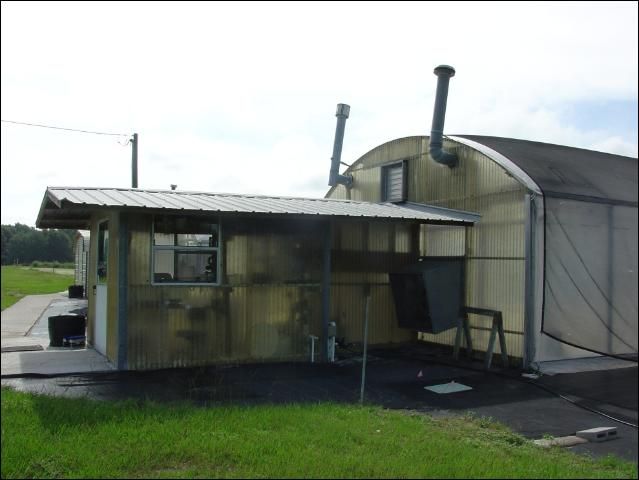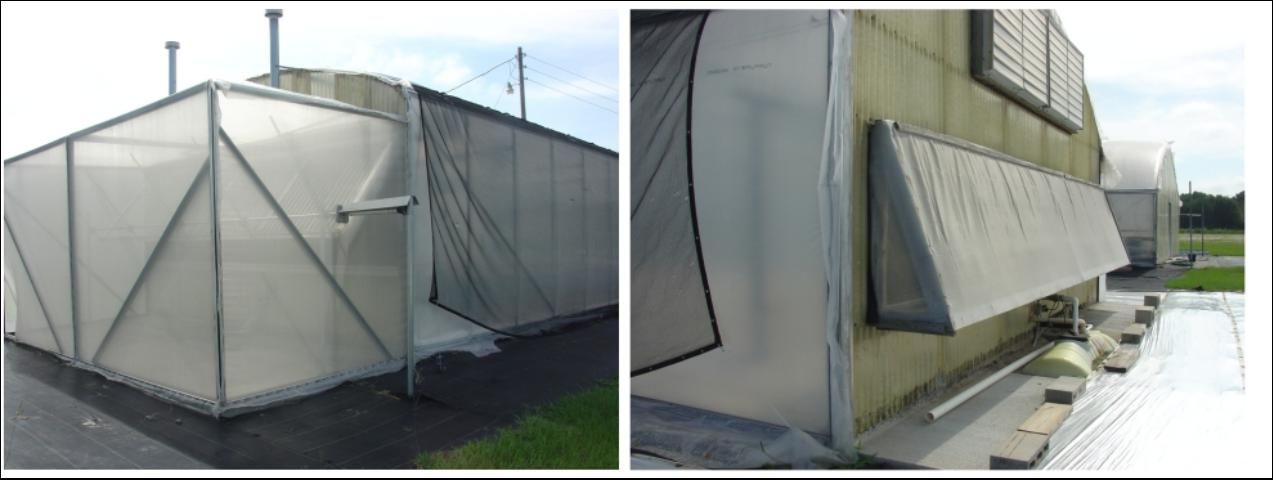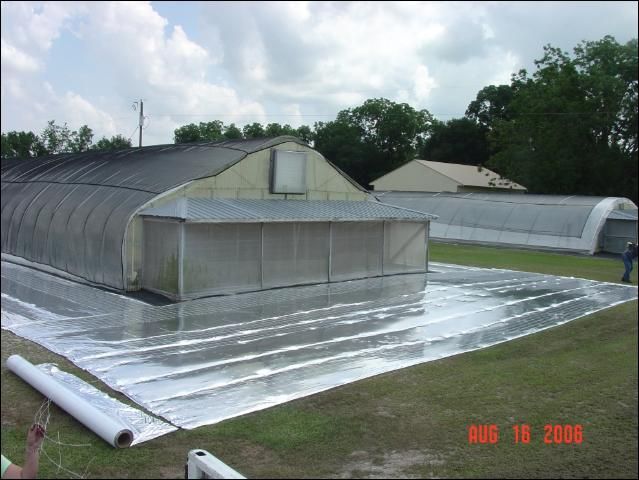Introduction
The Florida greenhouse vegetable and herb industry represents about 80 acres of intensive production of high quality products. The industry produces a wide variety of crops including tomatoes, cucumbers, peppers, lettuce, strawberries, basil and other herbs (Tyson et al., 2004).
The industry in Florida generally has a competitive advantage during the winter months due to lower heating costs compared to other areas of the U.S. and Canada. This advantage sets the stage for a market window that requires planting in the early fall, (August – September). This timeframe has high insect populations making pest management perhaps one of the most important production aspects, especially for tomato. The primary tomato pest during the fall is the silverleaf whitefly. The impact of this pest is magnified by the role it plays in transmitting plant viruses. The viruses transmitted to greenhouse tomato include tomato chlorosis virus, a problem appearing in 1990s and tomato yellow leaf curl virus, a much more serious virus since 2000 (Momol et al., 2001). In addition, the silverleaf whitefly is responsible for a tomato fruit ripening disorder known as irregular ripening.
The extra challenge in managing insect-vectored viruses in greenhouses is related to the long growing season for the crops. For instance, Florida greenhouse tomatoes are transplanted in September and grown through May or June by keeping the same plants and using cultural practices like leaning and lowering (Hochmuth, 2001). Once whiteflies enter the greenhouse and begin feeding, high levels of virus transmission are likely in Florida even if the whiteflies are killed later. Therefore, insect pest exclusion must be the first strategy in an integrated pest management program.
Insect Pest Exclusion Techniques
- Sanitation. It is important to keep the area around the exterior of the greenhouse free of weeds and other plants that could harbor pests. The ground immediately adjacent to the greenhouse can be kept clean by using nursery cloth or a ground cover in at least a 10–20 foot wide barrier. If any weeds grow in that barrier area, they should be destroyed. In addition, maintaining a pure grass area after the nursery cloth barrier as far as practical is suggested. Take an inventory of other plants in the yard area to determine their relative risk as a pest harbor. Remove plants that present a high risk due to attracting and harboring pests.
- Air-lock entrance. The walk-in doorways in the greenhouse provide an easy entrance to many pests. Growers need to evaluate various strategies to reduce the likelihood of pest entrance. In greenhouses with a fan and pad type ventilation, an air-lock entrance room is essential. The added room is attached to the exterior of the greenhouse enclosing the entry doorway (Figure 1). The double door system allows workers to enter the air lock room and close the outside door behind them prior to entering the greenhouse production area. Without the airlock room, the fans pull air in through the unprotected doorway rather than a screened opening at the opposite end of the greenhouse. It is common to see pest infestations beginning in plants close to an unprotected doorway. Even in passively ventilated greenhouses, a secure entrance room is important in regulating easy entrance of pests to the production area. These rooms can also be used to maintain a footbath, hand washing area, and any other sanitation techniques for workers.

3. Resistant cultivars. The number of pest resistant cultivars in various greenhouse crops has greatly increased in recent years. In some cases, using a resistant cultivar is the most successful method in an IPM strategy. One of the challenges in greenhouse vegetable crop production is the need for multiple resistances. Carefully research information on new resistant cultivars that may potentially fit your production and market demands. Be sure the cultivar will not only to solve a specific pest problem, but will also be accepted by consumers in the market. Try to evaluate new cultivars in a small portion of your crop area before changing entirely to an untested cultivar.
4. Insect screening. Modern technology in manufacturing has developed the capability to produce screening material so fine insects can be excluded from the greenhouse (Baker and Shearin, 2001; Murphy and Ferguson, 2000). Insect screens with a fine mesh that excludes insects from the greenhouse can be an important addition to an IPM program (Figure 2). Screens can be used effectively in both passively ventilated and fan and pad greenhouses. Any screens added to a ventilation opening will reduce airflow through that opening. So, it is important to follow the manufacturers recommendations to increase the surface area covered by the screen to compensate for the reduction in airflow. The reduction in airflow can burn fan motors or reduce cooling by reducing ventilation. Recent studies by the University of Florida with growers in the Live Oak area confirmed silverleaf whiteflies will enter through unscreened roof vents even 20 feet above ground. Therefore, roof vent openings in passively ventilated greenhouses may need to be screened for whiteflies and other flying insects.

5. Reflective or metalized mulches. Highly reflective or metalized plastic mulches have been used in agriculture for many purposes, but primarily for the repelling effects on certain insects. Metalized mulches are effectively used in field production by covering the narrow raised beds in full-bed polyethylene mulch production system. Research at the UF/IFAS North Florida Research and Educational Center in Quincy showed a 30–50 reduction in a thrips-vectored virus, tomato spotted wilt, in field tomato production. Researchers at the University of Florida tested the same approach around the outside of the greenhouses with wide strips of the metalized mulch (Figure 3). On-farm trials in Suwannee County Florida were conducted in the fall of 2006 to evaluate the effect on reducing whitefly populations from entering the greenhouse. Preliminary results suggest the metalized mulch was effective in reducing silverleaf whitefly entrance by 90% though the cool pad opening in a fan and pad system. The initial trials suggest it is important to have a continuous metalized mulch barrier 20 feet wide from the ventilation air intake end wall. Additional mulch along the sidewalls may also help repel the whiteflies away from the air intake area. The combination of screening and metalized mulch should be used together and will provide the greatest total reduction of whitefly entry.

6. Scouting and insect monitoring. Even after implementing all the previous exclusion techniques, some insects will certainly get inside the greenhouse. Early detection of pests in the crop is crucial. Use pest monitoring tools and techniques like yellow sticky traps, plant scouting and examining plants with a hand lens to make early detection of pests. Usually a pest infestation is location specific. For instance, hot spots of pests near ventilation or doorway openings are common. Another common discovery is insects coming into the greenhouse on infested plants from other areas. If you purchase transplants, consider all factors related to the source of plants that can increase pest problems. For example, determine if the transplant growing facility is in an area where pest populations are high and if the growers implementing good IPM practices.
7. Control strategies. If pest populations build to a threshold level requiring a control measure, growers must be prepared to implement a control plan immediately. Determine the current specific spray or biological control recommendations. The first decision in implementing a control program will be to choose either a biological or traditional pesticide strategy. Many excellent biological control agents are now available against common pests. If virus transmission from insect vectors (silverleaf whitefly transmitting yellow leaf curl virus) is an issue, be cautious with biological control strategies. This is because some low level of a pest population is generally needed to "feed" the beneficial agent. If pesticides are going to be used, carefully examine the choices and use the safest effective materials available. Follow a good pesticide rotation program to slow the development of pesticide resistance. Many of the "soft" or "biorational" pesticides such as soaps, oils, neem products, Bacillus thuringiensis (Bt) and others can play an important role in an IPM program for greenhouse vegetables.
Summary
It is important for Florida greenhouse vegetable producers to implement as many IPM exclusion strategies as possible to manage pests. Many of the serious insect pests of greenhouse vegetables, including aphids, silverleaf whitefly, and western flower thrips, require special control efforts due to their ability to vector plant viruses to the crop. Once these pests enter the greenhouse, growers have very few options to manage them. Therefore, excluding the pests from entering the greenhouse is critical. A virtual tour of the IPM topics covered in this document can be viewed on the Virtual Field Day website (http://vfd.ifas.ufl.edu)
References
Baker, James R. and E.A Shearin. 2001. Insect Screening for Greenhouses. http://www.ces.ncsu.edu/depts/ent/notes/O&T/production/note104.html
Hochmuth, G. 2001. Production of Greenhouse Tomatoes – Florida Greenhouse Vegetable Production Handbook, Vol 3. (https://edis.ifas.ufl.edu/cv266)
Momol, T., S. Olson, J. Funderburk, and R. Sprenkel. 2001. Management of Tomato Yellow Leaf Curl Virus (TYLVC) in Tomato in North Florida. https://edis.ifas.ufl.edu/pdffiles/NF/NFREC100.pdf
Murphy, G. and G. Ferguson. 2000. Screening of Greenhouses for Insect Exclusion. Ontario Ministry of Agriculture Fact Sheet 00-021 (AGDIEX 290/626) 8 pages.
Tyson, R.V., R.C. Hochmuth, E.M. Lamb E. McAvoy, T. Okzyk and M. Lamberts. 2004. Greenhouse Vegetables in Florida's Mild Winter Climate – 2004 Update. Acta Hort. 659. ISHS 2004. p. 37-40